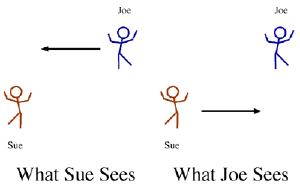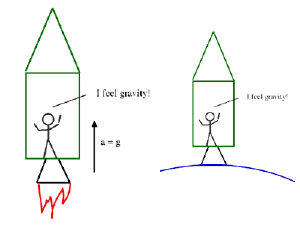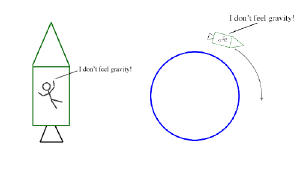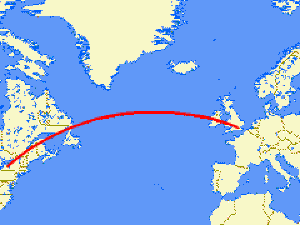Post
The Attraction of Curves
18 March 2012
An earlier post about black holes stimulated several questions about their nature. Of course to really understand black holes you need to understand Einstein’s theory of general relativity and the curvature of space and time. So today I’ll present Einstein simplified. Ignore the math, fudge a bit on the details, and you’re left with the central idea: no observer is special. The consequence of this is that gravity is not a force but the curvature of space.
General relativity is the relativity of gravity. Before we can talk about that, we must first review the idea of relativity without gravity, known as special relativity. For this, let’s imagine two astronauts (Sue and Joe) floating freely in space. There are no forces acting on either of them, so Sue and Joe both feel as if they are at rest. As they float past each other, Joe and Sue see things differently.

Sue says “I am at rest, and Joe is moving at a constant speed!”, while Joe says “Not so! I am at rest, and Sue is moving at a constant speed!” The reason they see things differently is that they assume their reference frame to be the absolute and correct one. The principle of relativity says that there is no absolute reference frame. Thus, we can only say that Joe and Sue are moving relative to each other. Although Joe and Sue have different perspectives they can agree that each is moving relative to the other.
So how does this idea extend to gravity?
 Brian Koberlein
Brian KoberleinTo answer this question, we put Sue in a rocket ship. There are no windows in this ship, so Sue can only make observations within the ship. Joe is floating some distance away, and can watch Sue’s experiments. We are going to put Sue in four situations, and see what she observes. For the first situation, we put her rocket in the middle of deep space and accelerate it with the same rate as gravity on Earth. Since the rocket is accelerating, Sue will feel the force of of the floor upon her feet. If she drops a ball, it will appear to fall just as it would on Earth. Since Sue can’t see outside, she assumes she must be on Earth, and therefore declares “I feel gravity!”
For the second situation we place Sue’s rocket on Earth. She will observe the same behavior, and again declare that she feels gravity. In other words, Sue has no way to distinguish between sitting in a gravitational field on Earth and uniformly accelerating in empty space. For her they are exactly the same. Joe disagrees. He declares that Sue is being tricked, and only in the second case does she really feel the force of gravity.
 Brian Koberlein
Brian KoberleinIn the third case Sue floats freely in her rocket in the middle of deep space. She doesn’t feel any forces on her, and if she throws a ball it appears to travel in a straight line at a constant speed. Thus, Sue declares “I feel no gravity!”
Finally in the fourth case we place Sue in orbit around the Earth. As she falls around the Earth, everything in her rocket falls at the same rate. Again Sue seems to float freely. She doesn’t feel any forces on her, and if she throws a ball it appears to move in a straight line. Again, Sue declares “I feel no gravity!”
Meanwhile, Joe begins to get frustrated. “She has it all wrong!” he says. “She is being tricked since she can’t see outside her rocket. I can see the whole thing, and I know gravity is acting on her when she is in orbit, since she is not moving in a straight line. Newton said that if the rocket doesn’t move in a straight line at a constant speed then there is a force acting on it. That force is gravity!” And since Joe can see what is really going on, surely his observations are correct.
This is where Einstein steps in. Einstein proposed that relativity should work in general. This means that if Sue and Joe disagree there must be some assumption they are making which is incorrect. For special relativity, the incorrect notion was that of absolute speed. What could it possibly be in this case? It turns out that the incorrect assumption is that objects which change directions must have forces acting on them. That is true in most cases, but not in the case of gravity.
 Brian Koberlein
Brian KoberleinTo see how this could be, consider the path of an airline flight from New York to Tokyo. If you’ve ever taken such a flight you know the plane doesn’t fly due west, instead it flys over the north polar region. The flight takes the shortest distance between two points, but on a regular map the path looks like a longer curved line. The reason it looks curved on the map is due to the fact that the Earth is not flat. The map is flat, and assumes a flat Earth. There is no force causing the flight path to bend, but rather the curvature of the Earth that results in a curved path.
The same is true of Sue’s rocket. It follows the shortest path in space and time. The reason it looks curved to Joe is that he assumes space and time are flat, when in fact they are curved. The Earth bends space around it, thus near the Earth objects move in curved lines.
At last Sue and Joe can agree. In the first two cases Sue is in a non-inertial frame of reference, which is why Sue detects the appearance of a gravitational force, and in the last two cases Sue is in an inertial frame of reference, thus she feels no forces around her. Gravity is nothing more than an illusion. A trick of curved space.
Strange? Yes, but powerful as well.